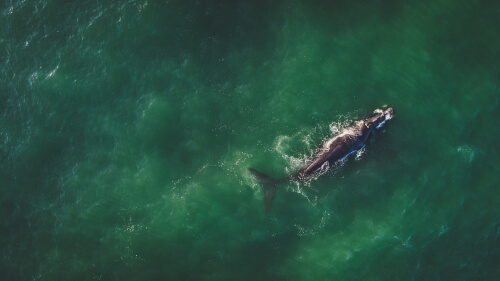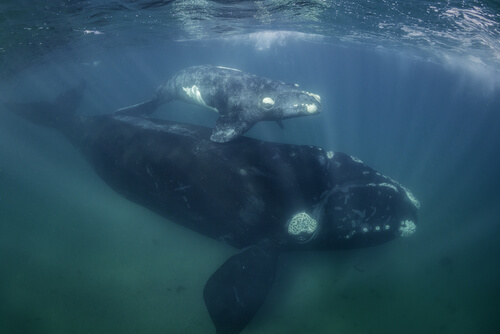
| Kingdom | Animalia |
| Phylum | Chordata |
| Class | Mammalia |
| Order | Artiodactyla |
| Family | Cetacea |
| Genus | Eubalaena |
| Species | E. australis, E. glacialis, E. japonica |
| Niche | Pelagic baleen whale |
| Length | 70 ft (20 m) |
| Weight | 290,000 lb (135,000 kg) |
| Lifespan | 70+ years |
| Social Structure | Complex family groups |
| Conservation Status | Endangered |
| Range | North Atlantic, North Pacific, Southern Hemisphere |
| Average Number of Offspring | 1 |
| Main Prey Species | Krill, copepods, pteropods (zooplankton) |
| Predators | Humans, orca |
The Basics
The right whale or black whale refers to three species of large baleen whales. These large animals can live for over 70 years and grows to almost 70 feet long. In terms of sheer body mass, it is second only to the blue whale and bowhead whale in size.
Description
The right whale refers to three distinct species, identified primarily by their distinct ranges. Also known as the black whale, their skin is a dark grey or charcoal color, appearing nearly black at times. It also has a broad back and a dorsal fin with occasional white patches on its belly.

Right whales are one of the largest extant species of whales, with adults normally measuring 35-60 feet in length and weighing nearly 300,000 pounds. Of the three species of right whales, the North Pacific species (Eubalanea japonica) is generally the largest. Their bodies are very thick, with their maximum girth measuring nearly 60% of their total length. They also have broad tail flukes and are covered with distinctive callosities – areas of rough skin, mostly on their heads.
Distribution and Range
The three species of right whale are distinguished primarily by their ranges. The North Atlantic right whale (E. glacialis) inhabits the chilly waters of the northern Atlantic ocean. Most live in its western portion, spending most of the year feeding along the coasts of eastern Canada and the northeastern United States. During the winter months, they will migrate south to Georgia and Florida to give birth and nurse.
The North Pacific right whale (E. japonicus) consists of two separate populations. In the eastern North Pacific and the Bering Sea, there is a very small populating of about 30 remaining individuals. There is also a population of about 200 individuals in the Sea of Okhotsk, near Russia. This species likely also completes a seasonal migration, although it is not understood or documented. It is also the most endangered of all right whale species and is currently projected to be extinct within 200 years.

The Southern right whale (E. australis) is the most abundant of the three species and can be found throughout the southern hemisphere. It migrates between far-south waters near Antarctica, where it spends the summer months feeding, and northern waters, where it travels to breed and nurse its young. During this time, southern right whales can be observed near the coasts of many countries in the southern hemisphere including much of South America, New Zealand, Australia, Mozambique, and South Africa.
Diet and Predators
Right whales travel between productive polar waters in the summer and more tropical regions during the winter, where they give birth and nurse their calves. They are baleen whales that subsist primarily on tiny organisms known as zooplankton. This may include copepods, krill, and pteropods. Right whales and other baleen whales have long plate-like structures in their mouths that they use to filter their food from the water as they swim. They will move through large high concentrations of zooplankton with their mouths open, gathering up whatever it can, including water. Then, it will close its mouth and push the water out with their tongues while the baleen plates contain their food.
The adult right whale faces few natural threats from predators due to its massive size. On occasion, orcas will attack large whales as a group, focusing particularly on calves. However, once abundant in all of the world’s oceans, by the end of the 19th century, the right whale was hunted nearly to extinction by whaling fleets.
Reproduction
Right whales are often solitary but are sometimes found in pairs or small groups. Little is known about their life history, but it is believed that they live for about 90 years and reach sexual maturity at about 5-15 years of age.
The gestation period for blue whales is 10-12 months. Mothers give birth to one calf which she nurses for up to 7 months. The calf is likely weaned while traveling towards their summer feeding grounds but may continue to travel with its mother for several years before reaching sexual maturity itself. Little is known about the species’ life history and breeding grounds, but blue whales and their calves are often observed in the Gulf of California (Sea of Cortez), suggesting that this is one important breeding and calving area for the populations in that part of the world.
Conservation
With more than 15,000 individuals, the southern right whale has recovered relatively well since the International Whaling Commission banned the practice of hunting whales. However, with populations still being greatly reduced from original numbers, the species is still listed as Endangered on the IUCN Red List of Threatened Species.
With only dozens of North Pacific right whales and hundred of North Atlantic right whales remaining, the two northern species have not recovered as well. With its slow reproductive rate and various threats from humans and climate change, these species are also considered Endangered on the IUCN Red List of Threatened Species and are considered currently on the path to total extinction, as has already occurred for other species and populations of right whales
Fun Facts about the Right Whale!
The right whale was named ‘the right whale’ to hunt due to its large amount of blubber and baleen in particular. However, there are many more fun facts to explore than just those related to its hunting to near extinction, including a world record of its own.
More Than a Little Teste
The right whale may not be as large as the blue whale, but it may just hold another record for size. The penis of a male right whale can grow up to nearly 9 feet long and its testes approximately 2.5 feet in diameter. Weighing more than 1,150 pounds, these testes are by far the largest of any animal in the world. The larger blue whale, for example, may be the largest animal on the planet, yet the testicles of the right whale are ten times the size of those of the blue whale.
They also exceed predictions in terms of relative size as well. Indeed, they are six times larger than would be expected based solely on body mass. In fact, the testicles of a right whale make up nearly 1% of its total body weight. These relatively and absolutely large testicles suggest that sperm competition is an important factor in right whale mating and may also explain the promiscuous nature of this species.
Built of Blubber
The right whale is very large and robust, growing nearly as big as bowhead whales and much larger than other species that normally visit shallow waters. Forty percent of their body mass is blubber, a relatively large amount in comparison to other whale species. This blubber, however, is not as dense as the blubber of other species, making them highly buoyant, which is an important consideration for diving marine mammals. Individuals that are not as well-nourished and have fewer energy reserves will require more energy to return to the surface from deep dives than those with more blubber.
Skin Prints
All species of right whales have a pattern of uncommon rough patches of skin on their heads known as callosities. These are outgrowths of tough, keratinized skin that ultimately become inhabited by three species of amphipod crustaceans (Cyamis ovalis, Cyamis gracilis, and Cyamis erraticus). These amphipods cause the callosities to appear white or orange. Also known as whale lice or cyamids, these amphipods feed on the whale’s skin and travel between whales by direct contact between whales.

The patterns created by these natural phenomena have long been used by researchers as a convenient tool used to tell one individual from another. In fact, in 2016, a competitive effort resulted in the use of facial recognition software to derive a process to uniquely identify right whales with about 87% accuracy based on their callosities.
